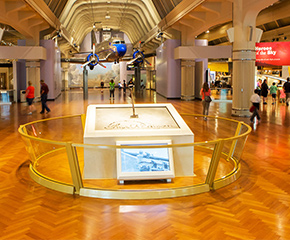Tinfoil Phonograph, 1878
Add to SetSummary
In 1877, Thomas Edison invented the phonograph, a machine for recording and playing back sound that was based on earlier work with telegraphs and telephones. This phonograph, which recorded recitation or music onto strips of tin foil, was manufactured for Edison by Sigmund Bergmann, a former employee. This "Concert" sized phonograph was meant for demonstrations of the astonishing new possibilities of recorded sound.
In 1877, Thomas Edison invented the phonograph, a machine for recording and playing back sound that was based on earlier work with telegraphs and telephones. This phonograph, which recorded recitation or music onto strips of tin foil, was manufactured for Edison by Sigmund Bergmann, a former employee. This "Concert" sized phonograph was meant for demonstrations of the astonishing new possibilities of recorded sound.
Artifact
Cylinder phonograph (Phonograph)
Date Made
1878
Location
Not on exhibit to the public.
Object ID
29.2002.73
Credit
From the Collections of The Henry Ford. Gift of Thomas A. Edison.
Material
Wood (Plant material)
Cast iron
Brass (Alloy)
Tin (Metal)
Dimensions
Height: 12.313 in
Width: 31.25 in
Length: 11.938 in
Diameter: 11.75 in (Flywheel)
Diameter: 5.55 in (Mandrel- approximate)
Inscriptions
MANUFACTURED BY / S. BERGMANN & CO. / NO. 104 WOOSTER ST. / N.Y. EXPERIMENTAL APPARATUS / FOR ILLUSTRATING THE PRINCIPLE OF / EDISON'S SPEAKING PHONOGRAPH / PAT. FEB. 19TH 1878 / NO. 144





